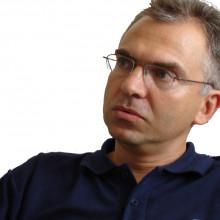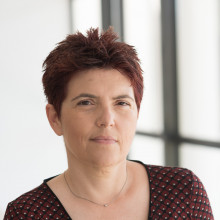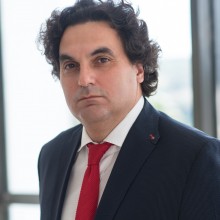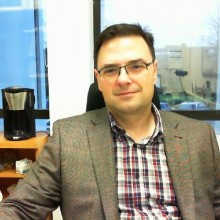Position Description
ΚΩΔΙΚΟΣ ΘΕΣΗΣ 6α
Ανάπτυξη και φυσικοχημικός Χαρακτηρισμός Υλικών
ΚΩΔΙΚΟΣ ΘΕΣΗΣ 6β
Σύνθεση και φυσικοχημικός χαρακτηρισμός υλικών
Για το πλήρες κείμενο της προκήρυξης ακολουθήστε τον σύνδεσμο "Related Documents"
Required Qualifications
ΚΩΔΙΚΟΣ ΘΕΣΗΣ 6α
- Πτυχίο σε Φυσικές επιστήμες
- Εργαστηριακή εμπειρία στην επιστήμη Υλικών
- Εμπειρία σε δομικό, οπτικό και ηλεκτρικό χαρακτηρισμό υλικών
ΚΩΔΙΚΟΣ ΘΕΣΗΣ 6β
- Πτυχίο Χημείας, Φυσικής ή Επιστήμη και Τεχνολογία Υλικών
- Μεταπτυχιακό στην Επιστήμη και Τεχνολογία Υλικών
- Εργαστηριακή Εμπειρία στα Υλικά
Desirable Qualifications
ΚΩΔΙΚΟΣ ΘΕΣΗΣ 6α
Εμπειρία στον χαρακτηρισμό φυσικών ιδιοτήτων της ύλης
ΚΩΔΙΚΟΣ ΘΕΣΗΣ 6β
Εμπειρία σε δομικό, οπτικό και ηλεκτρικό χαρακτηρισμό υλικών
Application Procedure
Στο φάκελο υποβολής της πρότασης θα πρέπει να εμπεριέχονται τα ακόλουθα:
- Αίτηση (Form Greek στην αριστερή στήλη) με αναφορά στον κωδικό της θέσης και στο όνομα του προγράμματος
- Αναλυτικό Βιογραφικό Σημείωμα
- Ευκρινή φωτοαντίγραφα τίτλων σπουδών
- Πρόσφατη βεβαίωση σπουδών υποψήφιου διδάκτορα
ΥΠΟΒΟΛΗ ΠΡΟΤΑΣΕΩΝ
Οι ενδιαφερόμενοι καλούνται να υποβάλουν τις αιτήσεις τους και όλα τα απαραίτητα δικαιολογητικά, ηλεκτρονικά στη διεύθυνση hr@iesl.forth.gr με κοινοποίηση (cc): στον Δρ Β. Μπίνα (binasbill@iesl.forth.gr). Οι αιτήσεις θα πρέπει να αποσταλούν με την ένδειξη: «Αίτηση στο πλαίσιο του προγράμματος SMAR-G, της πρόσκλησης εκδήλωσης ενδιαφέροντος με Α.Π. … και κωδικό θέσης … » (όπως αυτός αναφέρεται στον Πίνακα του Παραρτήματος).
Appointment Duration
4 μήνεςPosition Description
ΚΩΔΙΚΟΣ ΘΕΣΗΣ 1
Ανάπτυξη και Χαρακτηρισμός Φωτοκαταλυτικών Υλικών
ΚΩΔΙΚΟΣ ΘΕΣΗΣ 2
Ανάπτυξη και Χαρακτηρισμός Υλικών
ΚΩΔΙΚΟΣ ΘΕΣΗΣ 3
Ανάπτυξη και Χαρακτηρισμός Υλικών
ΚΩΔΙΚΟΣ ΘΕΣΗΣ 4
Ανάπτυξη και Χαρακτηρισμός Υλικών
ΚΩΔΙΚΟΣ ΘΕΣΗΣ 5
Μελέτη της φωτοκαταλυτικής δραστηκότητας Υλικών
Required Qualifications
ΚΩΔΙΚΟΣ ΘΕΣΗΣ 1
- Πτυχίο Φυσικής, Χημείας, Επιστήμης Υλικών
- Μεταπτυχιακό Δίπλωμα Ειδίκευσης στην Επιστήμη Υλικών
- Εργαστηριακή Εμπειρία
- Εμπειρία σε Χαρακτηρισμό και Ανάπτυξη φωτοκαταλυτικών Υλικών
ΚΩΔΙΚΟΣ ΘΕΣΗΣ 2
- Πτυχίο Φυσικής, Χημείας, Επιστήμης Υλικών
- Εργαστηριακή Εμπειρία
- Εμπειρία στην ανάπτυξη Υλικών
- Εμπειρία στον Χαρακτηρισμό υλικών
ΚΩΔΙΚΟΣ ΘΕΣΗΣ 3
- Πτυχίο Φυσικής, Χημείας, Επιστήμης Υλικών
- Εργαστηριακή Εμπειρία
- Εμπειρία στην ανάπτυξη Υλικών
- Εμπειρία στον Χαρακτηρισμό υλικών
ΚΩΔΙΚΟΣ ΘΕΣΗΣ 4
- Πτυχίο Φυσικής, Χημείας, Επιστήμης Υλικών
- Εργαστηριακή Εμπειρία
- Εμπειρία στην ανάπτυξη Υλικών
- Εμπειρία στον Χαρακτηρισμό υλικών
ΚΩΔΙΚΟΣ ΘΕΣΗΣ 5
- Πτυχίο Φυσικής, Χημείας, Χημικού Μηχανικού
- Μεταπτυχιακό στην Φυσική, Χημεία, Χημική Μηχανική
- Διδακτορικό στην Φυσική, Χημεία, Χημική Μηχανική
- Εργαστηριακή Εμπειρία
- Μελέτη της φωτοκαταλυτικής δραστικότητας υλικών
Desirable Qualifications
ΚΩΔΙΚΟΣ ΘΕΣΗΣ 1
Εμπειρία στον σχεδιασμό διατάξεων αέριας/υγρής φωτοκατάλυσης
ΚΩΔΙΚΟΣ ΘΕΣΗΣ 2
Εμπειρία στον χαρακτηρισμό της φωτοκαταλυτικής απόδοσης υλικών
ΚΩΔΙΚΟΣ ΘΕΣΗΣ 3
Ανάπτυξη διατάξεων για τον χαρακτηρισμό φωτοκαταλυτικής δραστικότητας υλικών στην αέρια φάση
ΚΩΔΙΚΟΣ ΘΕΣΗΣ 4
Εμπειρία σε χαρακτηρισμούς φωτοκαταλυτικής δραστικότητας υλικών
ΚΩΔΙΚΟΣ ΘΕΣΗΣ 5
Εμπειρία στον χαρακτηρισμό υλικών
Application Procedure
Στο φάκελο υποβολής της πρότασης θα πρέπει να εμπεριέχονται τα ακόλουθα:
- Αίτηση (Form Greek στην αριστερή στήλη) με αναφορά στον κωδικό της θέσης και στο όνομα του προγράμματος
- Αναλυτικό Βιογραφικό Σημείωμα
- Ευκρινή φωτοαντίγραφα τίτλων σπουδών
ΥΠΟΒΟΛΗ ΠΡΟΤΑΣΕΩΝ
Οι ενδιαφερόμενοι καλούνται να υποβάλουν τις αιτήσεις τους και όλα τα απαραίτητα δικαιολογητικά, ηλεκτρονικά στη διεύθυνση hr@iesl.forth.gr με κοινοποίηση (cc): στον Δρ Β. Μπίνα (binasbill@iesl.forth.gr). Οι αιτήσεις θα πρέπει να αποσταλούν με την ένδειξη: «Αίτηση στο πλαίσιο του προγράμματος SMAR-G, της πρόσκλησης εκδήλωσης ενδιαφέροντος με Α.Π. … και κωδικό θέσης … » (όπως αυτός αναφέρεται στον Πίνακα του Παραρτήματος).
Appointment Duration
4 μήνεςTo: 03/05/2023 14:00
Following the graphene craze, the scientific community is currently interested in the properties of new 2D materials that exhibit extraordinary optical and electrical properties: the family of Transition Metal Dichalcogenides (TMDs). These materials are semiconductors with a tunable bandgap that ranges from the visible to the near-infrared spectrum. It is crucial to measure the charge and spin transport properties of these materials and develop ultrathin optoelectronic and/or spintronic devices based on TMDs. In this talk, I will focus on the transport properties of WSe2 monolayers using optical spectroscopy. WSe2 is known to host a wide range of excitons, which are strongly bound electron-hole pairs. I will first analyze the transport properties of excitons when coupled to an electron reservoir (trionic species) and then demonstrate how it is possible to strongly spin/valley polarize the electron sea. The transport of this polarization can be carried out on a much larger scale than the classical exciton diffusion lengths, reaching up to tens of microns. Finally, I will show novel results of unidirectional excitonic transport on a coplanar WSe2/MoSe2 structure.
This project receives funding in the European Commission’s Horizon 2020 Research Programme under Grant Agreement Number 818087.
Position Description
Ο/Η υποψήφιος/α θα στελεχώσει μία διεπιστημονική ερευνητική ομάδα η οποία στο πλαίσιο του έργου PoweR-LIBS αναπτύσσει προηγμένες διατάξεις φασματοσκοπίας πλάσματος λέιζερ με δυνατότητα διεξαγωγής μετρήσεων και λήψης πειραματικών δεδομένων από απόσταση (remote, stand-off analysis) καθώς και κατάλληλη οργανολογία με στόχο την εφαρμογή της στην αξιολόγηση της λειτουργικής κατάστασης πολυμερικών μονωτήρων χρησιμοποιούμενων σε δίκτυα μεταφοράς ηλεκτρικής ενέργειας, υψηλής τάσης. Επίσης ο/η υποψήφιος/α αναμένεται να συνεργαστεί με εταίρους του έργου για την ανάπτυξη μεθόδων τεχνητής μάθησης (machine learning, deep learning) για την αξιολόγηση και κατηγοριοποίηση/διαβάθμιση της κατάστασης των μονωτήρων.
Για το πλήρες κείμενο της πρόσκλησης ακολουθήστε τον σύνδεσμο 'Related Documents'
Related Project
PoweR-LIBS -Required Qualifications
- Διδακτορικό στις φυσικές επιστήμες ή επιστήμες μηχανικού (Φυσική, Χημεία ή συναφείς επιστήμες)
- Υψηλού επιπέδου γνώση και εμπειρία στην εφαρμογή φασματοσκοπικών τεχνικών λέιζερ για την ανάλυση και το χαρακτηρισμό υλικών
- Εμπειρία στο σχεδιασμό και ανάπτυξη φασματοσκοπικών διατάξεων
- Εμπειρία στη μελέτη φαινομένων αλληλεπίδρασης λέιζερ-ύλης με έμφαση σε διεργασίες φωτοαποδόμησης (laser ablation)
Desirable Qualifications
- Ερευνητικό / επιστημονικό έργο μετά την απόκτηση του διδακτορικού (επιστημονικές δημοσιεύσεις και παρουσιάσεις σε συνέδρια)
- Εμπειρία στην επεξεργασία και ανάλυση φασματοχημικών δεδομένων. Γνώση μεθόδων χημειομετρίας
Application Procedure
ΑΠΑΡΑΙΤΗΤΑ ΔΙΚΑΙΟΛΟΓΗΤΙΚΑ
Στο φάκελο υποβολής της πρότασης θα πρέπει να εμπεριέχονται τα ακόλουθα:
- Αίτηση (Form Greek στην αριστερή στήλη) με αναφορά στον κωδικό της θέσης και στο όνομα του προγράμματος
- Αναλυτικό Βιογραφικό Σημείωμα
- Ευκρινή φωτοαντίγραφα τίτλων σπουδών
ΥΠΟΒΟΛΗ ΠΡΟΤΑΣΕΩΝ
Οι ενδιαφερόμενοι καλούνται να υποβάλουν τις αιτήσεις τους και όλα τα απαραίτητα δικαιολογητικά, ηλεκτρονικά στη διεύθυνση hr@iesl.forth.gr με κοινοποίηση (cc): στον καθηγ. Δ. Άγγλο (anglos@iesl.forth.gr). Οι αιτήσεις θα πρέπει να αποσταλούν με την ένδειξη: «Αίτηση στο πλαίσιο του προγράμματος PoweR-LIBS, της πρόσκλησης εκδήλωσης ενδιαφέροντος με Α.Π. … και κωδικό θέσης … » (όπως αυτός αναφέρεται στον Πίνακα του Παραρτήματος).
Appointment Duration
5,5 μήνεςFunding

To: 26/04/2023 14:00
The wide applicability of 2D materials have resulted in great achievements in many fields of science over the last 15 years, including energy production and storage, optoelectronics, environmental and biomedical applications and so on. [1] However, a deeper investigation on their exceptional properties and the capability for solution processing, as well as the development and exploitation of emerging nanomaterials could further increase the performance of well-established applications. [2,3] Motivated by this, some contributions in the field of nanotechnology based on graphene and beyond materials will be presented. Finally, challenges to be addressed, outline research directions and future perspectives will be discussed.
[1] C. Backes et al., 2D Mater. 2020, 7, 022001
[2] D. Konios et al., J. Col. Interf. Sci. 2014, 430, 1
[3] A. VahidMohammadi et al., Science 2021, 372, eabf1581
Position Description
Study of mechanotransduction mechanisms and subsequent cell responses of the neural stem cells encapsulated in 3D adipose-ECM-derived hydrogels
For the full announcement, follow the link "Related Documents"
Required Qualifications
- BSc degree in Biology
- Laboratory experience in Cell Cultures, Biochemical and Molecular Biology Techniques
- Excellent knowledge of English
Application Procedure
Interested candidates who meet the aforementioned requirements are kindly asked to submit their applications to the address (hr@iesl.forth.gr), with cc to Dr Anthi Ranella (ranthi@iesl.forth.gr).
In order to be considered, the application must include:
- Application Form (Form Greek or Form English to the left)
- Brief CV
- Scanned copies of academic titles
- University department certificate for enrollment in a master’s program
Appointment Duration
6 monthsPosition Description
Synthesis and functionalization of colloidal nano-dispersions with organic molecules
For the full announcement, follow the link "Related Documents"
Required Qualifications
- BSc in Chemistry or Materials Science
- MSc in Chemistry or Materials Science
- Experience in the synthesis of organic molecules
- Publication relevant to the position topic
Application Procedure
Interested candidates who meet the aforementioned requirements are kindly asked to submit their applications to the address (hr@iesl.forth.gr), with cc to Dr Emm. Stratakis (stratak@iesl.forth.gr).
In order to be considered, the application must include:
- Application Form (Form Greek or Form English to the left)
- Brief CV
- Scanned copies of academic titles
- Certificate for enrollment in a PhD program
Appointment Duration
12 monthsPosition Description
Μετρήσεις ρεολογίας σε σύνθετα διαλύματα πολυμερών-κολλοειδών σωματιδίων και μελέτη φαινομένων διατμητικής λέπτυνσης (shear thinning) και πάχυνσης (shear thickening) και των εφαρμογών τους σε αντιβαλλιστικές εφαρμογές
Required Qualifications
- Πτυχίο Θετικών Επιστημών ή Χημικής Μηχανικής
- Εγγεγραμμένος/η σε μεταπτυχιακό πρόγραμμα σπουδών τμημάτων Υλικών, Φυσικής, Χημείας ή Χημικών Μηχανικών
- Εργαστηριακή εμπειρία σε χαρακτηρισμό και ρεολογικές μετρήσεις χαλαρών υλικών, τουλάχιστον 3 μήνες
- Γνώση αγγλικής γλώσσας τουλάχιστον επιπέδου Β2
Application Procedure
Στο φάκελο υποβολής της πρότασης κάθε ενδιαφερόμενου θα πρέπει να εμπεριέχονται τα ακόλουθα στοιχεία:
- Αίτηση με αναφορά στο αντικείμενο της θέσης
- Αναλυτικό Βιογραφικό Σημείωμα
- Ευκρινή αντίγραφα τίτλων σπουδών
- Αποδεικτικό γνώσης της αγγλικής γλώσσας
- Βεβαίωση εγγραφής σε μεταπτυχιακό πρόγραμμα σπουδών
- Βεβαίωση εργοδότη και οποιοδήποτε άλλο έγγραφο μπορεί να πιστοποιήσει την εμπειρία
- Αντίγραφο πτυχιακής εργασίας
ΥΠΟΒΟΛΗ ΠΡΟΤΑΣΕΩΝ
Οι ενδιαφερόμενοι καλούνται να υποβάλουν τις αιτήσεις τους και όλα τα απαραίτητα δικαιολογητικά το αργότερο μέχρι και 5/4/2023, 16:00
Οι αιτήσεις θα πρέπει να υποβάλλονται ηλεκτρονικά, με όλα τα απαραίτητα δικαιολογητικά, στη διεύθυνση kleanthi@iceht.forth.gr με κοινοποίηση (cc) στον Δρ. Γ. Βογιατζή, gvog@iceht.forth.gr , με την ένδειξη: «Βιομηχανική ανάπτυξη ελαφριών θωράκων προστασίας σώματος για στρατιωτικές και πολιτικές-εμπορικές εφαρμογές (ΘΩΡΑΞ-Δ / THORAX-D)» με Α/Α 1.
Appointment Duration
6 μήνες"Earth Overshoot Day", on which we have consumed more than the sustainable resources available to us, is continuously shifting towards the beginning of a year. In 2022, this date was July 28, i.e., we are consuming 175% of the amount of resources that would be sustainable. A way to reverse this trend is to move away from a linear economy toward a circular system where materials are fully reused and recycled. The European Union has committed itself to support this transition to a European circular economy.
ReMade@Ari (Recyclable Materials Development@Analytical Research Infrastructures) is the response to this call of more than 50 European facilities from the Analytical Research Infrastructures in Europe (ARIE). The aim of this EU project is to support materials research and development for a circular economy of key components in the most diverse sectors, such as electronics, batteries, vehicles, construction, packaging, plastics, textiles and food production. We will support researchers from academia and industry by providing our broad expertise in materials synthesis, modification and characterization techniques as well as our unique analytical instruments at large scale facilities and specialized labs using photons, electrons, neutrons, ions, positrons and highest magnetic fields. Our expert network and a pool of junior researchers specialized in the specific techniques will provide advice during the proposal preparation as well as active support during the beamtimes and the data analysis in this trans-national access project. The new approach in this trans-national access project is to combine a least two complementary techniques from the different ARIE networks to address the scientific and analytical questions in a comprehensive manner and to foster interdisciplinary approaches.






